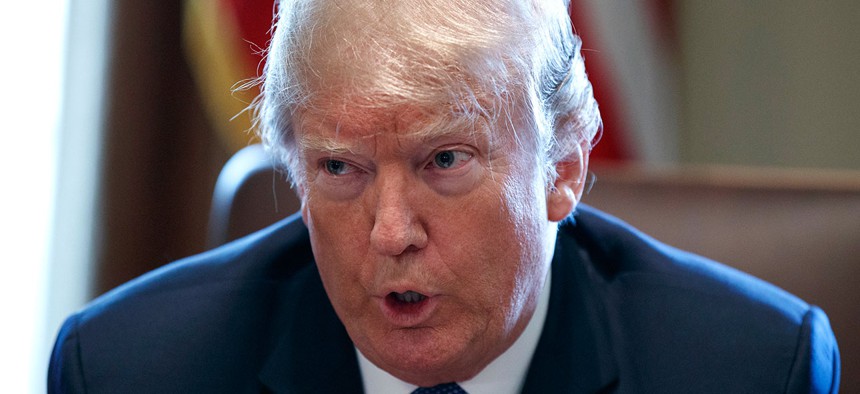
Donald Trump speaks during a cabinet meeting at the White House on Monday. Evan Vucci/AP
What Is America Going to Do About Syria Now?
After the latest suspected chemical attack, the United States has four options.
Donald Trump says there will be a “big price to pay” for Syrian President Bashar al-Assad’s suspected use of chemical weapons in the rebel-controlled town of Douma outside Damascus. But what exactly could that mean? Beyond responding to this particular attack, what can the United States really do about Assad’s depravity and flouting of international norms at this point in the seven-year conflict? The paths forward can be sorted into at least four broad categories.
(1) Massive Military Engagement
No one in the Trump administration—not President Trump, not Defense Secretary James Mattis, neither freshly installed National-Security Adviser John Bolton nor Secretary of State-designate Mike Pompeo—has expressed interest in removing the Assad regime by force and rebuilding the Syrian nation, the way the U.S. overthrew Saddam Hussein in Iraq. But some have advocated pushing back hard against Assad and particularly his Iranian allies in Syria. In 2015, Bolton went so far as to propose that the United States carve out an independent Sunni Muslim state in northeastern Syria and western Iraq. If “defeating the Islamic State means restoring to power Mr. Assad in Syria and Iran’s puppets in Iraq,” pleasing Russia and Iran at the expense of the United States, Israel, and America’s Arab partners, “that outcome is neither feasible nor desirable,” he wrote.
“The U.S. has to decide whether it can accept Assad’s (and therefore Iran’s) absolute control of most of Syria,” said Faysal Itani, an expert on the Syrian conflict at the Atlantic Council. If this is unacceptable, then the Trump administration needs to mobilize much greater U.S. military power and enlist local proxy forces and regional partners in a new campaign to “either force [Assad] to share power or defeat him.” Former U.S. Secretary of State Rex Tillerson once articulated goals of ousting Assad through a political settlement and beating back Iranian influence in Syria. (The speech, like Tillerson, has since disappeared from the State Department’s website.) But “those things cannot happen without a military component to U.S. policy” that goes beyond fighting the last vestiges of ISIS in the country, Itani told me. The military offensive could begin modestly with, for example, a “buildup of assets” in southern Syria, where anti-Assad forces still control some territory.
But whatever big price Trump hopes to levy on Assad, Trump faces one of his own if he makes good on his threat. “The cost of meaningfully changing the [military and political] balance in Syria has become prohibitively high over the last few years,” Itani said, as Russian and Iranian forces have intervened on behalf of Assad, ISIS has risen and fallen and soaked up all of America’s attention, and Assad and his allies have retaken most of Syria’s core territory and relegated thinning ranks of rebel fighters to a couple corners of the country. “What was once a realistic goal in the first years of the war”—even, perhaps, when Obama contemplated and ultimately rejected military retaliation against Assad’s use of chemical weapons in 2013—“has become fraught with risk.” This is particularly true for Trump, who just last week was boasting about how the United States would soon withdraw its small military presence from Syria once ISIS is defeated and quit sinking trillions of dollars into the region.
“Even a committed president would struggle to sell [an anti-Assad military operation] publicly, but ... it would run against the instincts of an impatient and uninterested president who doesn’t want to fight another Middle East war whatever his anti-Iranian staff may say,” Itani said. “I find it unlikely the president would abandon his core beliefs and go to war with the Iranians and possibly even the Russians, because that is what removing Assad would entail.” (Consider that while the U.S. military under Trump has engaged in occasional turf battles with Russian mercenaries and Iranian-affiliated militias in Syria, it was a big deal for Trump, in condemning the latest chemical attack, to merely call out Vladimir Putin by name.)
(2) Limited Military Engagement
Similar to the way the Trump administration launched Tomahawk missiles against a Syrian airbase one year ago to punish Assad for a chemical attack, the United States could “use pinpointed military force to pressure Assad” and deter him from employing chemical weapons, said Andrew Tabler, a Syria scholar at the Washington Institute for Near East Policy.
Such strikes could be accompanied by initiatives such as American reconstruction aid to parts of Syria not controlled by Assad, diplomacy with Russia and U.S. allies in Europe and the Middle East, and potentially renewed covert support to Syrian rebels (Trump and then-CIA Director Pompeo cut off this assistance in 2017). All of which could raise the costs of propping up the Syrian regime and thus drive a wedge between Russia and Iran “over bringing Assad to the negotiating table,” increasing the likelihood of reaching a “political settlement in which Assad eventually departs” and is replaced by a centralized government that can prevent terrorist groups from regenerating and Iran from holding sway over Syria.
The challenge, according to Emma Ashford of the Cato Institute, is that if the U.S. applies “too little force” against Assad, as she believes Trump did last year in inflicting minimal damage on a Syrian airfield, “it sends the message that we are not willing to actually enforce norms against chemical-weapons use.” (If the Syrian government did indeed carry out the chemical attack in Douma this weekend, it would not be its first since Trump decided to enforce America’s red line against the use of chemical weapons.) Apply too much force, and you reduce chemical-weapons usage at the risk of “empowering extreme rebel groups, increasing the intensity and duration of the war, and adding to civilian casualties in the long run.”
“At a minimum, I suspect we’ll see another round of symbolic [U.S.] airstrikes against targets inside Syria,” Ashford told me. “It’s also entirely possible that the president will see the repeated use of chemical weapons after last year’s airstrikes as a personal affront and decide to take more substantive military action against Assad. However, given the president’s apparent disdain for ‘nation-building,’ any military action is likely to be short-term and to leave other states and Syria’s people to pick up the pieces.”
“Assad will push, pull, prod, and plot ceaselessly … only pausing when confronted with superior force,” said Tobias Schneider, a research fellow at the Global Public Policy Institute in Berlin. For Assad, “this war is existential and only an existential threat would make [him] change course.”
Rather than aiming to deter Assad from using chemical weapons , a more realistic goal for limited U.S. strikes is to sanction those who commit atrocities and degrade the Syrian military’s ability to harm its own people, Schneider reasoned. “There is no shortage of targets: facilities associated with chemical-weapons programs, airbases used for their delivery, and [the] headquarters of the notorious air force intelligence service, which [is believed to have] coordinated the most recent attacks. ... A broader assault could include munitions factories [and] maintenance and supply bases that keep the teetering loyalist forces afloat.” If Russians or Iranians get caught in the crossfire, however, the intervention could quickly escalate.
(3) Diplomatic and Humanitarian Engagement
Given the unattractive military options, Ashford recommended that the United States aggressively pursue “humanitarian and diplomatic steps” such as supporting the Syrian refugees dispersed among Syria’s neighbors and leading efforts to strike a peace deal in Syria, “an endeavor that has largely been abandoned under the Trump administration.”
The crisis over the attack in Douma should prompt the Trump administration to ask whether the United States is “drawing red lines around chemical weapons to save face, to save norms, or are we trying to save civilians?” Schneider said. “It is clear the U.S. and her allies will not dislodge Bashar al-Assad from office, but they will have to live with the consequences of his survival. Any new policy designed in Washington should focus on the fates of those Syrians left out of the above equation: those bombed, starved, displaced from their homes and unlikely to return. Syrians stuck in the messy, marginal communities, marbled with Islamists of all stripes, that Bashar al-Assad is dedicated to beating and gassing into submission—or pushing across the border—to cement his reign.”
(4) Military Withdrawal
James Dobbins, the special representative for Afghanistan and Pakistan during the Obama administration, told me that in the near term a “punitive” U.S. strike “may be necessary to sustain U.S. credibility” regarding the chemical-weapons taboo. But afterwards, he proposed, the United States should offer to remove its troops from Syria and “normalize relations” with the Assad government once the U.S-allied Kurds are granted autonomy within their enclave of Syria and all foreign militias, particularly those associated with Iran, are withdrawn from the country. He predicted, however, that the Trump administration would not take this approach, instead pairing strikes against Assad with “continued ineffectual calls for Assad to go.” That’s “the path of least resistance” in terms of U.S. domestic politics, he explained.
“Assad has won the civil war,” Dobbins recently wrote. “The Syrian state has been closely aligned with Russia and Iran for decades. … The best that can be hoped for at this late stage is that post-war Syria is no worse than pre-war Syria.”
“I am very wary of recommending a course of action that I do not think the United States will pursue responsibly and see through,” said Itani, who for years called for U.S. and allied military action against Assad and Iranian-backed militias to end the Syrian war. “I would prefer we do nothing [militarily against Assad], to yet more humiliation for” the United States.
Melissa Dalton of the Center for Strategic and International Studies, meanwhile, suggested a hybrid of several of these options: a mix of American measures such as punitive strikes against Syrian aircraft used in Douma, sanctions for nations that have supported Assad’s deployment of weapons of mass destruction, a push for a negotiated end to the Syrian war that holds Assad accountable for his WMD use and large-scale conventional violence, and a commitment to sustained counterterrorism and stabilization missions in Syria. Through these moves, she argued, the United States could not just address terrorism and WMD proliferation, but also counteract Iran and Russia.
What Dalton expects, however, is for the Trump administration to take narrower actions, which she worries will address neither “the underlying drivers of civil war” nor the “conditions that allow ISIS and like-minded groups to fester.”







